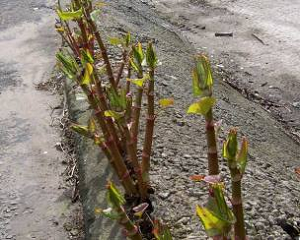Diary of a 1st time seller, aged 33 ¼ – Entry 6
 Click here for previous entries
Click here for previous entries
Entry 6: Much ado about knotweed
The more avid readers of my seller’s diary (hi mum), will have noticed that I’ve been pretty quiet for the past few months. That’s because unfortunately after four nail-biting months, my buyer pulled out, my sale collapsed…and it’s all down to Japanese knotweed; a plant that until it tore through my life, I’d never even heard of.
Everyone’s sale is different. Mine personally didn’t have the result I was looking for, but I’ve learned a lot and now understand that if handled with caution, knotweed doesn’t have to be the property grim reaper it’s made out to be. Here’s my experience of the dreaded knotweed with advice from a seller and expert perspective on how to tackle this property hot-potato if it lands on your turf.
My sale was plodding along nicely and searches came back fine… until my agent called in a panic. The conversation went something like this:
My agent: “Nat, I think you’d better sit down. I’m sorry to have to tell you that Japanese knotweed has come up on the survey on some land near your boundaries. I’d brace yourself for the worst.”
Me: “JESUS CHRIST, I thought you were going to tell me my house was about to collapse! A plant is flowering near my house, fine, I’ll get a trowel and fish out my Barbour jacket”
Gradually it became more apparent how serious this problem could be. My family reeled in horror when I told them, the google searches filled me with fear and stories of people being stuck with an unsellable homes consumed my mind. I felt sick.
To give you a little background, Japanese knotweed is a flowering plant that was first introduced to Britain from the Far East in the 19th century. Back in Japan, its manifestation is kept in check by indigenous insects. But in blighty we don’t have these insects, meaning the knotweed is left to grow – up to 10cm a day, destroying everything in its path… even properties. It’s common, with experts saying that there’s not a 6 square mile section of the UK that doesn’t contain the plant. The UK government estimate that the potential cost of trying to eradicate knotweed is £1.25 billion. Cripes.
As a real-life seller faced with this problem, the thing that worried me sick me was the hysteria surrounding this housing pandemic. There didn’t feel like there was any knowledge or a process in place from the experts acting on behalf of my buyer or myself. Instead we faced a lot of negativity and confusion. I felt like I was drowning in complicated jargon and those who could lead the charge were as clueless as me. After 6 weeks of panic, misery, and blindly trying to fix the problem, my sale stopped.
However, I have since learned a lot for the next time I attract a buyer, which I will now impart on you. Don’t freak out when listening to the hype and take control of the situation fast! The problem may not be as bad as you are led to believe, and even if it is, you’ll still have a good chance of selling if you act FAST!
My advice if Japanese knotweed comes up on your survey
1. Get some knowledge quick!
- Google image “Japanese knotweed” and try and identify it yourself to understand the extent of the problem. It may not even be on your property but the surrounding area. It may also not be Japanese knotweed at all, surveyors are sensitive about the plant and often get it wrong. Take pictures of it and keep them to hand.
- Arm yourself with knowledge via The RHS and Environmental Agency, they are factual, balanced and tell you your rights.
- Check out this handy guide on what to do if Japanese knotweed comes up on a Home Buyers survey
2. Don’t try and remove or cut down the plant yourself, it needs to be dealt with by an expert. Botch jobs will delay treatment of the plant which in turn could hinder your sale.
3. Communication is vital! Keep talking to your agent, solicitor and buyer. Like dry rot, and rising damp, Japanese knotweed is a complication, not a death sentence, so make sure all parties are aware of developments and solutions as soon as possible – the more knowledge people have, the less likely they are to panic and pull out.
4. If not on your land, make your local council aware of the knotweed, as they will offer advice and may even treat it themselves at no cost to you.
5. Again, if not on your land, find out who owns it fast. Speak to the land registry if it’s empty and get details of ownership. Tell the land owner immediately of the problem and ask how they will deal with it so you’ve an action plan to share with your chain.
6. The mortgage lender will normally ask for a professional survey of the problem (at around £300). Do the leg work now and start shopping around for a local PCA-accredited contractor who has previously done surveys with that lender. They will have experience of what the lender is looking for to make their decisions and bundles of advice.
normally ask for a professional survey of the problem (at around £300). Do the leg work now and start shopping around for a local PCA-accredited contractor who has previously done surveys with that lender. They will have experience of what the lender is looking for to make their decisions and bundles of advice.
Although fruitless, my contractor was fantastic, re-assuring and my only real ally in the process, so I asked him to provide some further advice expert on knotweed, read it here.
Written by Natalie, a first-time seller aged 33 ¼.


